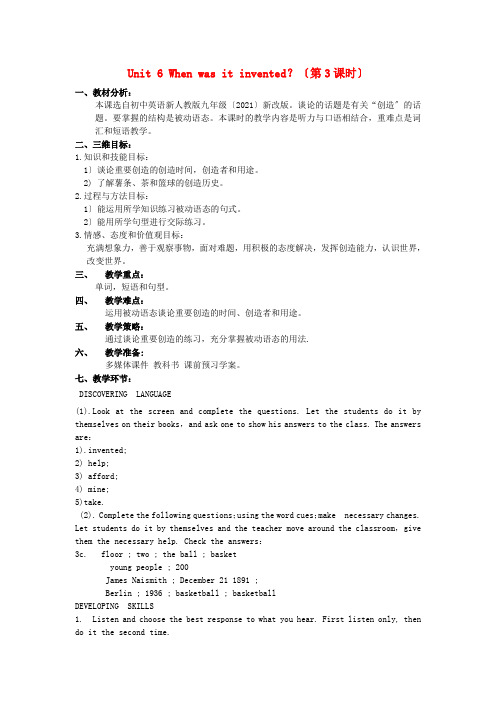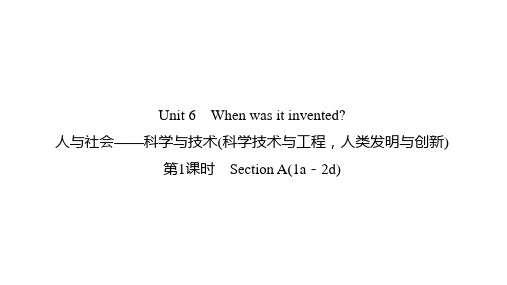2018-2019学年人教版英语九年级上册Unit 6 When was it invented (2)
- 格式:doc
- 大小:61.50 KB
- 文档页数:9

Unit 6 When was it invented?单元检测题一、听力理解 (本大题分为A、B、C、D四部分,共25小题,每小题1分,共25分)A. 听句子, 根据所听句子和所提的问题,选择符合题意的图片回答问题。
每小题听一遍。
( )1.What’s the girl looking for?A. B. C.( )2.What are the children doing?A. B. C.( )3.What can the boy see in the box?A. B. C.( )4.Which invention is the speaker talking about?A. B. C.( )5. What’s Nick doing?A B. C.B.听下面九段对话,根据每段对话的内容回答其后面的问题,从题中所给的A、B、C三个选项中选出最佳选项。
每段材料听两遍。
听第一段对话,回答第6小题( )6. What`s the machine used for?A. For washing clothes.B. For cleaning the floor.C. For wiping the leather shoes.听第二段对话,回答第7小题( )7. What does the man think of the light bulb?A. It makes us work late every day.B. It helps us live an interesting life.C. It makes the daytime longer in some extent (程度).听第三段对话,回答第8小题( )8. When was the telephone invented?A. In 1900.B. In 1927.C. In 1876.听第四段对话,回答第9小题( )9. What’s the man’s idea?A. He thinks the TV set is the most important invention.B. He thinks the car is the most important invention.C. He thinks the telephone is the most important invention.听第五段对话,回答第10小题( )10. How much will the man pay for the room for two?A. $ 28.B. $ 38.C. $ 76.听第六段对话,回答第11小题( )11. What can we learn from the dialogue?A. Students are not allowed to wear slippers in school.B. Students are allowed to wear slippers in school.C. It is very cool for students to wear slippers in school.听第七段对话,回答第12小题( )12. Why is the man here?A. He is going to take a bus.B. He wants to show his friend the way.C. He is going to meet his friend.听第8段对话,回答第13至第15题( )13. When will they plan to go out?A. On Wednesday evening.B. Tomorrow evening.C. On Thursday evening. ( )14. What does Peter ask Anna to do?A. Go to a party.B. Go to the park.C. Go to the cinema and have dinner together.( )15. How will they go?A. By bike.B. By car.C. On foot.听第9段材料,回答第16至第17题( )16. Where did the girl stay during her holiday?A. In a hotel.B. In a farmer’s house.C. In the open air.( )17. When did the girl get back?A. In the morning.B. In the afternoon.C. In the evening.C.听短文,根据短文内容,回答第18至第20题。

Unit6 When was it invented?短语归纳____________________ 2.偶然;意外地 ________________________________________ 4.想出,想起,考虑_______________考虑____________________ 考虑____________________ 5.落入;陷入____________________ _________________________________ 8.……的本质___________________________________(反:多于_______________) 10.发生;出现;举行___________ 11.……的普及____________________ 12.毫无疑问;的确_____________________________________ 14.把……翻译成……_________________15.突然;猛地___________________ 16.从事;致力于___________________ 17.错误地;无意中______________ 18.想出,提出____________________ ______________ 20.把……分成……________________________________________ 22.阻止……做……____________________23.梦想;向往___________________ 24.不但……而且……__________________25.……的数量____________________ 大量的……____________________26.钦佩;仰慕___________________ ______________________________________ ____________________30.与……类似____________________Section A1.changing the style of the shoes改变鞋的样式style〔名词〕样式;款式the style of... ……的样式out of style 过时in style 流行,时髦The style of the blouse is my mother's favorite.2.—Can you help me think of an invention?你能帮我想个发明吗?—With pleasure!乐意效劳!1) Can you do...?你能做……吗?此句型表示客气地请求某人做某事,其肯定回答一般为“Sure, I'd love/like to./With pleasure.”。

Unit 6When was it invented?Language Goal【语言目标】Talk about the history of inventions Knowledge Goals【知识目标】Key Wordsstyle,project,pleasure,daily,website,pioneer,list,mention,ruler,boil,remain,smell,national,trade,doubt,fridge,low,somebody,translate,lock,ring,earthquake,sudden,bell,biscuit,cookie,musical,instrument,sour,customer,Canadian,divide,basket,hero,nearlyKey Phrases have a point,by accident,take place,without doubt,all of a sudden,divide…into,not only…but also…,look up to,the Olympics,by mistakeKey Sentences1.—When was the telephone invented?—I think it was invented in 1876.2.—I think the TV was invented before the car.—Well,I think the TV was invented after the car.3.—Who was it invented by?—It was invented by Whitcomb Judson.4.—What is the hot ice-cream scoop used for?—It's used for serving really cold ice-cream. 5.The telephone was invented by Alexander Graham Bellin 1876.Key Grammar Learn to use passive voice in past tense to talk about inventions.Learn the special questions and answers.Ability Goals 【能力目标】1.Develop listening,speaking,reading and writing skillsby using the target languages.2.Learn to talk about the history of inventions and ask when,who and what questions about the famousinventions and answer them.Moral Goals 【情感目标】1.With the help of this unit's study,students can learn about the important inventions and how they have changed the world and the life of human beings. 2.Learn from the inventors and work hard at our lessons.Teaching Time【课时】Five periodsPeriod 1Section A(1a-2d) Period 2Section A(3a-4c)Period 3Section B(1a-1e)Period 4Section B(2a-2e)Period 5Section B(3a-3b) & Self Check本单元围绕“发明”这一话题,学习了解一些重要发明的历史,教学一般过去时的被动语态。

Unit 6 When was it invented?〔第3课时〕一、教材分析:本课选自初中英语新人教版九年级〔2021〕新改版。
谈论的话题是有关“创造〞的话题。
要掌握的结构是被动语态。
本课时的教学内容是听力与口语相结合,重难点是词汇和短语教学。
二、三维目标:1.知识和技能目标:1〕谈论重要创造的创造时间,创造者和用途。
2) 了解薯条、茶和篮球的创造历史。
2.过程与方法目标:1〕能运用所学知识练习被动语态的句式。
2〕能用所学句型进行交际练习。
3.情感、态度和价值观目标:充满想象力,善于观察事物,面对难题,用积极的态度解决,发挥创造能力,认识世界,改变世界。
三、教学重点:单词,短语和句型。
四、教学难点:运用被动语态谈论重要创造的时间、创造者和用途。
五、教学策略:通过谈论重要创造的练习,充分掌握被动语态的用法.六、教学准备:多媒体课件教科书课前预习学案。
七、教学环节:DISCOVERING LANGUAGE(1).Look at the screen and complete the questions. Let the students do it by themselves on their books,and ask one to show his answers to the class. The answers are:1).invented;2) help;3) afford;4) mine;5)take.(2). Complete the following questions;using the word cues;make necessary changes. Let students do it by themselves and the teacher move around the classroom,give them the necessary help. Check the answers:3c. floor ; two ; the ball ; basketyoung people ; 200James Naismith ; December 21 1891 ;Berlin ; 1936 ; basketball ; basketballDEVELOPING SKILLS1. Listen and choose the best response to what you hear. First listen only, then do it the second time.2. Listen to Miss Green’s lecture and decide whether the following statements are true or false. Make the answers by class themselves.3. Work in pairs.Interview the partners in your group, ask them some questions and write down, then report to the class.Read the passage and choose the best answersTell the students to read the dialogues carefully,and think it over,then complete it. First ask the students talk about his or her answers with classmates. Check the answers :1. invent ; nearly ; all of a sudden ; doubt ;websites ; mention1). My watch was stolen by someone .2). Five eggs was used to make this bigcake by them .3). When was the personal computerinvented by them4). We were asked not to run in thehallway by them .5). The video was taken back to thestore by someone .homework1.Write a passage about a new invention and introduce it.2.Do some relevant exercises .(设计说明:运用并拓展本课时所学知识,让学生在写作中进一步稳固所学知识,并掌握本课时的新词和短语。


人教版九年级英语Unit6 When was it invented?知识要点语法:1、被动语态(1). 被动语态表示句子的主语是谓语动词所表示的动作承受者。
(2). 被动语态基本结构:be+及物动词的过去分词(如果是不用物动词,其过去分词应带有相应的介词)(3). 被动语态中的be 是助动词,有人称、数和时态的变化。
一般现在时被动语态为:am/is/are+过去分词一般过去时被动语态为:was/were+ 过去分词与情态动词连用的被动语态:情态动词+ be + 过去分词(4). 被动语态中动作的发出者或执行者做介词by的宾语,放在句末,by 表示“由,被”的意思2、如何理解被动语态?为更清晰、更深刻地理解被动语态的含义,可以将主动语态和被动语态的句子结构进行比较。
主动语态:主语+ 谓语动词+ 宾语+ 其他成分被动语态:主语+ be +过去分词+ by +宾语+其他成分如:被动语态English is spoken by many people.课文知识要点:1、When was it invented?它是什么时候发明的?invent v. 发明→inventor n. 发明家→invention n. 发明可数名词invent v. “发明”指发明创造出自然界本来不存在的东西,如工具、方法、手段、汽车、电器、合成材料等。
Bell invented the telephone. 贝尔发明了电话。
Smith invented a new teaching method. 史密斯发明了一种新的教学方法。
Edison, a great inventor, invented over 1’000 inventions all his life.2、What is it used for?它是用来做什么的?be used for“用来做…”;此短语中的for是介词,表示用途,后接名词或动词-ing形式。
课题:Unit 6 When was it invented? 教学设计教学目标1. 语言知识目标:一、重点词汇:invent,invention,inventor ,calculator二、通过问答,掌握以下句型:1. A: When was the telephone invented?B: I think it was invented in 1876.2. A: What are they used for?B: They’re used for seeing in the dark.三、1.正确运用被动语态谈论重要的发明的历史和用途。
2.掌握一般过去时态的被动语态, 由was/were +过去分词构成。
学会单词invent, 以及be used for 的用法备注2. 情感态度价值观目标:通过熟悉我们周围经常使用发明物的历史来开阔眼界,丰富自己的阅历,使自己养成勤于思考,善于总结的好习惯。
重难点1. 教学重点:1) 熟练掌握以下词汇:style, project, pleasure, mention2) 正确运用被动语态谈论重要的发明的历史和用途。
3)掌握一般过去时态的被动语态, 由was/were +过去分词构成。
学会单词invent, 以及be used for 的用法。
2. 教学难点:被动语态/be used for 的用法。
教学方法任务型教学法,听说法课时SectionA 1a-2d 教学准备PPT 收音机教学过程第一课时创设情境目标领航Ⅰ. Lead inShow pictures of the four great inventions. Say “ Today we are going to talk about inventions. Do you know what an invention is?These are the four great inventions in ancient China. They were invented a long time ago.” Show some pictures about modern inventions(computer,television,telephone and car). Tell students that all of these things were invented in the last 150 years,Point to each picture and let students tell what it is. Then write the names of the inventions.设计意图:通过图片帮助学生理解invention的含义,引出更多发明名称,为下一步谈论发明做好词汇准备。
教师学生时间和时段2016年月日(:—:)学科英语年级九年级上教材名称人教版授课题目Unit6 When was it invented? 课次第()次课【短语归纳】1.the style of……的样式17. all of a sudden 突然;猛地2.such a great invention 如此了不起的一项发明18. by mistake 错误地;无意中3.be used for 被用于….. 19. in the end 最后4.by accident 偶然;意外地20.a cook called George Crum 一个名叫乔治·卡拉姆的厨师5.think of/ about 想/考虑21. more than 多于;超过6.fall into 落入/陷入22. the Olympics 奥林匹克运动会7.in our daily life 在我们的日常生活中23. divide…into…把…分成…8.some time 一段时间24. at the same time 同时9.the saint of tea 茶圣25. stop…from doing…阻止…做…10.less than 少于;不到26. dream of/ about 梦想;向往11.take place 发生;出现27. not only…but also…不但….而且…12.in the 19th century 在十九世纪28. the number of……的数量13.the popularity of……的普及29. more and more 越来越….14.without doubt 毫无疑问;的确30. look up to 钦佩;仰慕15.at a low price 以低价31. achieve one’s dreams 实现某人的梦想16.translate.. into.. 把..翻译成…32. take notes 记笔记33.lead to 导致【用法集萃】1. It is said that…据说…2.It is believed that…人们认为….3. ask sb. (not) to do sth. 要求某人(不要)做某事4. teach sb. to do sth. 教某人做某事5. need to do sth.需要做某事6.encourage sb. to do sth.鼓励某人做某事7. be used to do sth. 被用于做某事Section Al. I think the TV was invented before the car. 我认为电视是在小汽车之前被发明的。
Unit 6 When was it invented?单元教材分析类别课程标准要求掌握的项目单元话题In this unit,students learn to talk about thehistory of inventions.单元语法Passive voice(past tense)教学目标1.能掌握以下句型:①—When was the telephone invented?—I think it was invented in1876.②—What are they used for?—They are used for seeing at night.2.能谈论物品被发明的时间、发明者,表达某发明的用途。
3.了解一些近现代发明的时间及用途,激发自己热爱发明的情感。
培养想象力,善于观察事物。
面对难题,用积极的态度去解决,发挥想象力,认识世界,改造世界。
学情分析本单元话题是发明,学生们对发明不太熟悉,因此教师在讲前应普及下有关发明的知识。
在畅谈发明话题时自觉运用被动语态的过去时态。
课时教学设计第一课时Section A (1a-2d)1.重点单词:heel,scoop,electricity,style,project,pleasure,zipper,daily,website,pioneer,list,mention2.重点短语:be used for,think of,have a point3.重点句式:—When was the telephone invented?—I think it was invented in 1876.What are they used for?Can you help me think of an invention?Is it really such a great invention?Think about how often it's used in our daily lives.The pioneers of different inventions were listed there.At that time,it wasn't used widely.1.重点短语和句型。
Unit 6When was it invented?第1课时Section A(1a~2d)【学习目标】【课堂导学案】Step 1情景导入(5分钟)T:There are many useful things in the world.They help us a lot in life.(Show some pictures on the screen)Question:When were they invented?Students:________________________________________________________________________(1)The telephone was invented in 1876.(2)The computer was invented in......环节说明:通过课前的一个师生问答互动引入新课的话题;通过图片的展示和语言的描述创设了情境,激发了学生的学习兴趣和表达欲望。
Step 2完成教材1a~1c教学任务1.要求学生迅速阅读1a部分的内容,并按要求完成课本上相应的任务:“Number the pictures”。
(1分钟)2.检查答案,要求全班一起给出答案并检查讨论。
(3分钟)3.要求学生听第一遍录音,并完成课本上1b的听力任务:“Listen and match the inventions w ith the years.”。
检查他们的答案,读出序号——读出年份——读出完整的句子。
(2分钟) 4.要求学生听第二遍录音,并逐句进行跟读。
(2分钟)5.完成教材1c的任务,要求学生模仿1a内容,进行对话练习,并邀请2~3对学生当堂进行演示。
(3分钟)6.小结训练。
(2分钟)用所给词的适当形式填空。
(1)When __was__ the telephone __invented__(invent)?(2)It __was__invented__(invent)in 1876.环节说明:通过学习1a,使学生对几种重要的发明有所了解,并拓宽了思路;通过学习1b,锻炼学生的听力及抓取关键信息的能力;通过1c的训练锻炼学生的口头表达能力,同时巩固对本课内容的认识。
Step 3完成教材2a~2d教学任务1.要求学生翻开课本。
播放第一遍录音,完成2a、2b的听力任务,然后个别检查,统一核对答案。
(2分钟)2.要求学生听第二遍录音,并逐句进行跟读。
(2分钟)3.听力内容巩固训练。
要求学生根据所听到的内容完成下列各句。
完成后要求若干学生给出自己的答案,以巩固对听力内容的理解。
(4分钟)The shoes with lights are used for seeing in the dark.They were invented by Julie Thompson.This hot ice - cream scoop is used for scooping really cold ice - cream.The shoes with special heels are used for changing the style of your shoes.4.大声朗读听力材料。
(1分钟)5.放下听力材料,要求学生模仿听力内容,利用2a、2b的信息分角色进行对话练习。
然后邀请2~3对学生当堂演示,看哪一对的表现最佳。
(5分钟)6.角色扮演(读2d对话,然后表演)。
(7分钟)环节说明:将听、说、读、写的任务结合起来,不仅锻炼了学生的语言综合运用能力,还巩固了学生对被动语态的学习、识记和运用。
7.小结训练。
(5分钟)按要求完成下列各题。
(1)Cars were invented in__1885.(对画线部分提问)__When__ __were__cars invented?(2)Julie Thompson invented electric slippers.(改为被动语态)Electric slippers __were__ __invented__ __by__ Julie Thompson.(3)The shoes with lights are used for seeing__in__the__dark.(对画线部分提问)__What__ are the shoes with lights __used__ __for__?(4)The light bulb was invented by Thomas__Edison.(对画线部分提问)__Who__ __was__the light bulb invented by?(5)The refrigerator is used to keep food fresh.(改为同义句)The refrigerator is used __for__ __keeping__food fresh.Step 4问题探究(3分钟)(B)1.Columbus________America in 1492.A.invented B.discoveredC.found D.found out(A)2.A pen is________writing.A.used for B.used toC.used by D.used as(B)3.Smith________a new teaching method(方法).A.discovered B.inventedC.is discovered D.was invented【课后作业案】完成本书课后提升案对应练习。
第2课时Section A(3a~4c)【学习目标】Step 1复习(1分钟)谈论汽车。
—When was the car invented?—It was invented in...Step 2情景导入(3分钟)T:Give three questions and lead in to new knowledge.1.Do you drink tea every day?2.Who invented tea in history?3.Do people in other countries drink tea in their daily life?环节说明:通过带着问题去学习短文,从而达到导入新课的目的,同时也可以使学生积极阅读短文,以了解更多的关于茶的知识。
Step 3完成教材3a~3c教学任务1.要求学生快速默读短文,熟知大意,并完成课本3a的任务,然后邀请几位学生给出自己的答案,全班一起学习讨论。
(3分钟)2.先邀请几位学生阅读短文(可一人一段),教师要注意学生的语音,给予必要的朗读指导。
然后播放录音,全班学生一起跟读。
(3分钟)3.读短文完成3b的任务(回答问题)及3c的任务(填空)。
(8分钟)4.短文内容巩固练习。
教师可给出一篇改写了的短文,将一些重点的单词空出,让学生在规定的时间内补全短文,然后找若干学生给出自己的答案。
(4分钟)Do you know tea?Tea is the most popular drink in the world.But to our surprise,it was invented by accident.It wasn't brought to the Western countries earlier.An ancient Chinese ruler Shen Nong discovered tea when he was boiling drinking water in the open air.Some leaves from a tea plant fell into the water and remained there for some time.And it has a nice smell.He tasted the brown water and it was delicious.And in this way,tea was invented.环节说明:将听、说、读、写的任务结合起来,不仅锻炼了学生的语言综合运用能力,还巩固了学生对语言目标的学习、识记和运用;同时,学生们还可以从茶的发现中获得生活的启示:要认真观察生活、实践生活,才能享受生活。
5.小结训练。
(4分钟)(B)(1)He is ________50 years old.A.near B.nearly C.nearby(C)(2)The flowers produce a nice________.A.taste B.sound C.smell(A)(3)Some________from a tea plant fell______the water.A.leaves;into B.leafs;intoC.leaves;off D.leafs;off(B)(4)They all wished us________.A.are remained B.to remainC.remaining D.be remainedStep 4完成教材Grammar Focus~4c教学任务1.要求学生翻开课本P44,参照4a所提供的信息和例句,用被动语态改写句子,并请4位同学在黑板上改写,全班集体核对答案。
(5分钟)2.用所给单词的正确形式完成4b句子。
并请5位同学朗读句子,全班集体核对答案。
(5分钟)3.先浏览4c的短文,确定空格处的动词是用主动形式还是被动形式,然后用动词的正确形式填空完成短文。
并请1位同学朗读短文,全班集体核对答案。
(5分钟) 4.小结训练。
要求学生在规定的时间内完成一个小练习。
并请若干学生给出自己的答案。
有错误的话及时纠正。
(2分钟)用括号内所给单词的适当形式填空。
(1)This instrument is used for __playing__ (play) music in class.(2)How many magazines were __borrowed__ (borrow) from the library today?(3)Edison was a great __inventor__.He had over 1,000 __inventions__ in his life.(invent)(4)A picture __was__put__ (put) on the blackboard before class.(5)Plates and dishes __weren't__washed__ (not wash) after supper yesterday.Step 5问题探究(2分钟)A.单项选择。